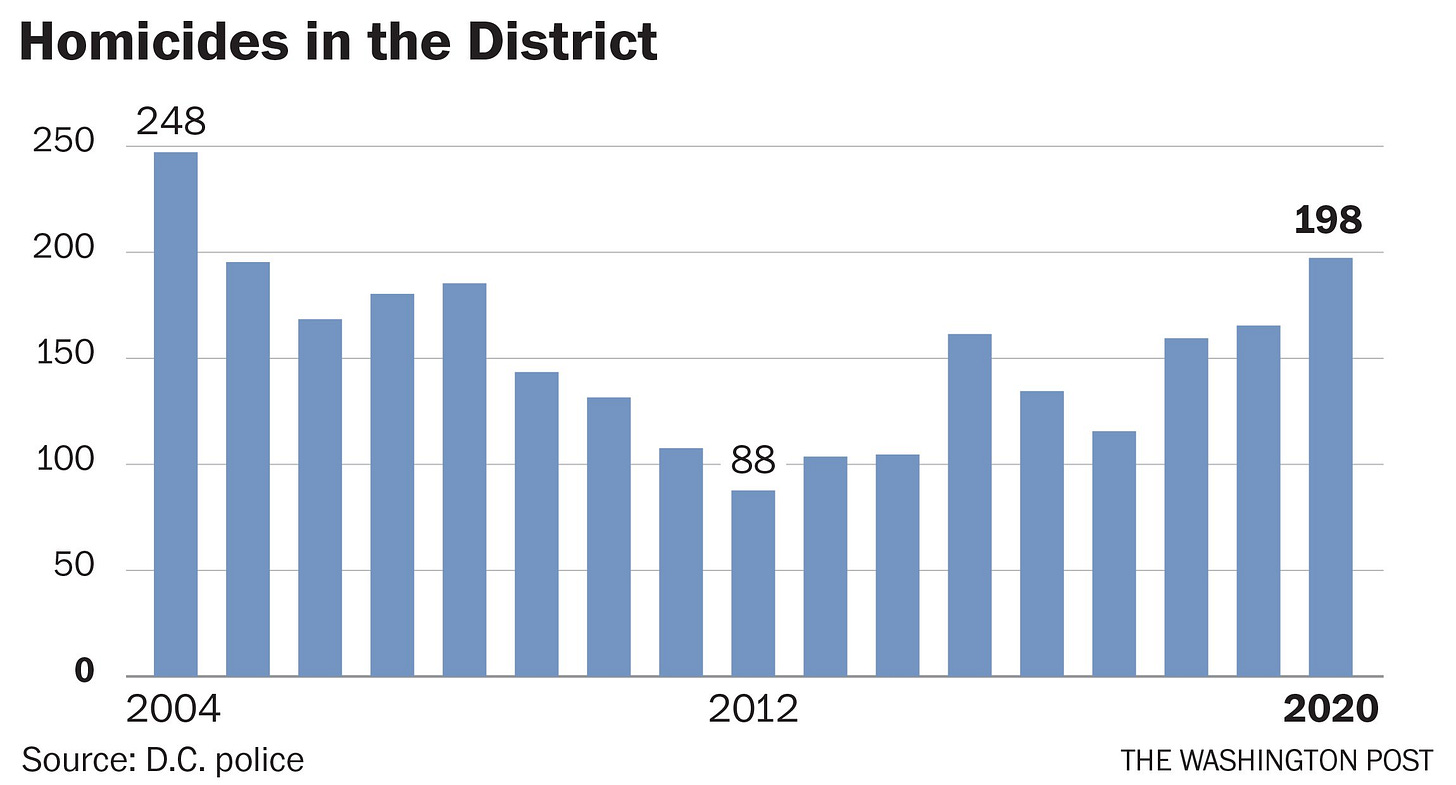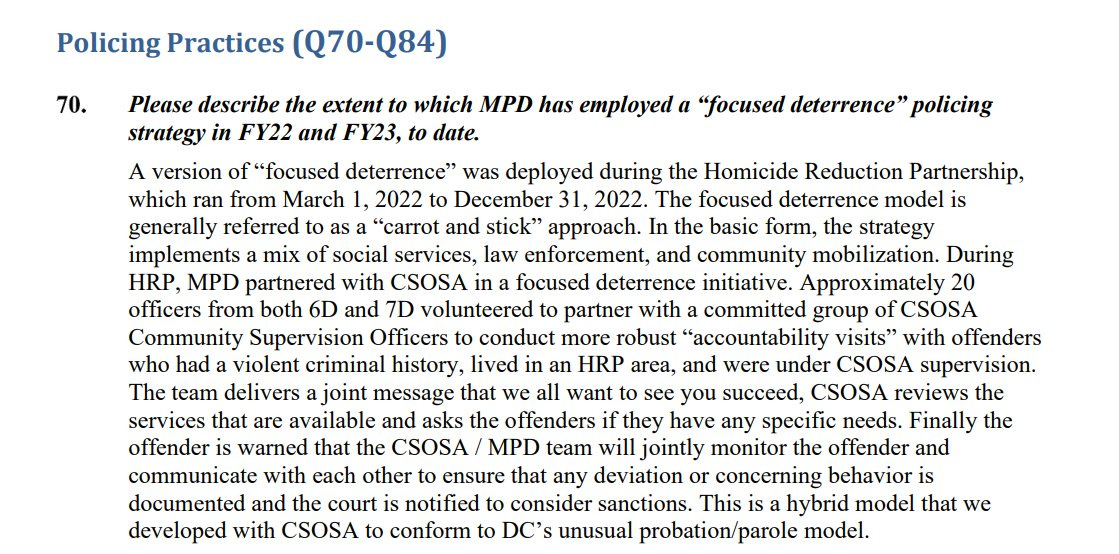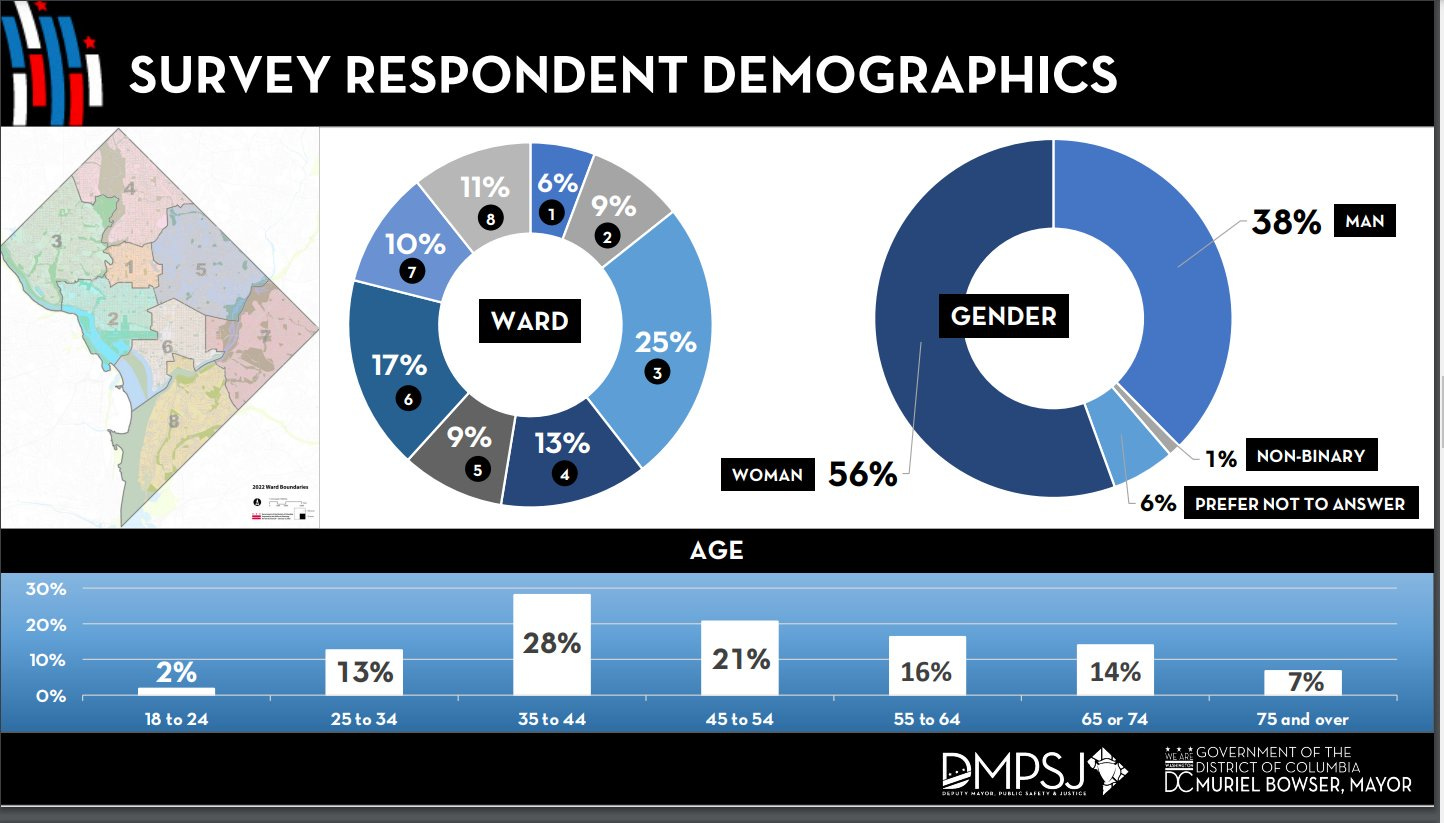DC’s crime debate reached a surprising amount of consensus on Tuesday as the DC Council passed a crime bill that Mayor Bowser has said she will sign. Councilmember Brooke Pinto managed to find areas of agreement between her own bills and the Mayor’s “Safer Stronger” proposal by passing a bill to “create a new offense for firing a gun in public, make it easier for prosecutors to extradite people for misdemeanor offenses, allow police and prosecutors to use GPS data from ankle monitors to prove people’s guilt in court, and expand an existing subsidy for residents and businesses who buy security cameras.” There were also provisions that expanded the presumption of pretrial detention for suspects accused of some violent crimes and make strangulation an offense. CM Pinto deliberately removed the most harmful or controversial parts of “Safer Stronger” (particularly pretrial detention for children that were NOT deemed a threat to the public) in order to build a 12-1 majority.
While this bill is net positive, tweaks to the law are much less impactful than improvements in enforcement. Recall that the USAO is only prosecuting about half as many cases as they did pre-COVID and in MPD arrests-per-officer are down ~41% with the largest decreases in DC’s most violent police districts. With violent crime now up 33% this year we need more serious changes on the ground. Thankfully, we actually know quite a bit from research about which policing strategies can help reduce crime. For this post we’ll:
Review policing best practices and the research evidence for their effectiveness
Show how MPD could implement them or expand their application
Discuss some of the possible reasons why MPD leaders, who definitely know about these best practices, have not been able to or allowed to fully implement these policies
There are no counterintuitive “this 1 weird trick solves all crime” solutions that actually work. However, there are pretty logical policies that help reduce crime and the Department of Justice has thankfully organized the research on many of these practices here. It’s worth noting that most of the best-attested practices involve long-term prevention strategies. I intend to circle back and do a post on them but since there’s public interest in “what can we do now?” I’ll be focusing on policing changes that the Mayor could implement at any time.
The first “best practice” is often called “Hot Spots Policing” and follows the intuitive principle that if one deploys police to the areas where most crime is happening their presence will deter crime and/or lead to arrests if crimes occur. This is very basic and is “used by the majority of U.S. police departments.” But as you can see, MPD doesn’t really allocate its police officers according to where crimes occur:
Manhattan Institute Fellow (and great Substack writer) Charles Lehman reacted to this scatter plot with “You think that "cops on dots" is such old hat that it's not useful advice anymore. But then you find out that the police force responsible for the nation's capital isn't doing it.” I suspect that within PSAs MPD does prioritize “relative hot spots” but the “hot spots” of the wealthy Palisades simply don’t even rate when compared to areas with above-average crime rates. In terms of evidence, the DOJ compiled a number of studies that show Hot Spots Policing really helps:
“aggregating the results from 35 independent tests, Braga and colleagues (2019) found an overall statistically significant weighted mean effect size of 0.109 in favor of hot spots policing.”
This same meta-analysis found an “effect size of 0.102” for violent crime specifically, 0.124 for property crimes, 0.161 for public order offenses and 0.244 for drug and alcohol offenses
These findings are both statistically significant and meaningful (~10-24% reductions in the various types of crime) which shows that Hot Spots Policing actually deters crime rather than simply displacing it to other areas.
The second policing best practice is Focused Deterrence. While Hot Spots Policing focuses on the small number of areas where most crime occurs, Focused Deterrence prioritizes the small number of people who commit most crimes (or certain types of crimes). The DOJ description covers the “carrots and sticks” of this approach:
Note that the police need to be credible in both directions for this messaging to work. They DO need to make arrests (and the USAO would need to prosecute) those that continue to break the law or else deterrence would break down. But police also need to “reward compliance” which may mean not making arrests on lower-level crimes that occurred before the “warning” phase. Also there need to be credible social service/employment off-ramps for people that do want to make a change (DC has a very mixed record in this regard). The evidence for this strategy is pretty good: “Across the 24 studies, Braga, Weisburd, and Turchan (2018) found that focused deterrence strategies were associated with an overall statistically significant crime reduction effect (d = 0.383)” “Precision Policing” is basically the “focus on a small group of people” part of Focused Deterrence and also has a pretty good track record. In New York City the police were forced to switch from “mass enforcement centered around frequent street stops and field interrogations to a more surgical regime of precision policing in which the department concentrated its focus on a small number of suspected criminal organizations that are thought to be the driver of an outsize share of the city’s gun violence.” As a result, the NYPD focused on “gang takedowns” and researchers found that “gun violence declines by approximately one third in the aftermath of a takedown.” There’s good evidence that focusing police resources on the small number of criminals that drive most crime (like the 200-500 people responsible for 60-70% of gun violence in DC) and pairing that with a “carrots and sticks” deterrence message can reduce crime.
DC definitely could do this and there’s pretty good evidence that we used to. In 2005 MPD, the USAO, OAG, FBI, DEA, ATF, CSOSA and the US Marshals launched a joint Homicide Reduction Strategy for DC. It’s almost a textbook for how to run a Focused Deterrence strategy across DC’s unique local-federal jurisdictional landscape. Note that this strategy launched in 2005 and coincided with a large drop in DC’s homicides:
I can’t fit an entire rundown of the strategy into this post but I did a Twitter thread about it and here are the highlights:
They focused on a small number of high risk gang/crew affiliated individuals associated with most violent crimes
MPD and the USAO together used “Intelligence Based Targeting” to select neighborhoods for prioritization
There was real, significant resource prioritization with MPD moving officers into the priority neighborhoods for 90-120 days and FBI/DEA/ATF adding in staff to bolster the effort. This multi-agency task force worked on building viable cases.
This multi-agency task force then did a coordinated “take down” of suspects to incapacitate criminals and generate cooperating witnesses against the most serious offenders
This “take down” is intended to help reduce crime in the priority neighborhood but is also meant to be a warning to other criminal groups
The task force worked with CSOSA to organize a “call in” (summons to the court house) of all of the suspected gang/crew members in other neighborhoods under CSOSA supervision. Failure to appear was grounds for a bench warrant.
The presentation to the suspected gang/crew members is INCREDIBLY BLUNT. The law enforcement representative show how they took down the original group (to include mug shots), “anecdotes and things we know about each of the attendees” and a promise that “we will come down on you” if they don’t refrain from violence.
After the harsh law enforcement presentation they would bring in clergy and social service providers to try and provide the “carrot” of help if the suspected gang/crew members rejected violence.
We can’t prove that this specific approach was (as implemented) responsible for DC’s reduction in homicides. But the fact that it does correlate with DC’s falling homicide rate AND studies have found that similar Focused Deterrence approaches work should pique policymakers’ interest. This sounds like how self-proclaimed “tough on crime” politicians say they want to message to criminals. But instead this is how Mayor Bowser’s MPD describes their “focused deterrence” efforts:
That is not Focused Deterrence by either the DOJ or 2005-era MPD definitions. It’s actually surprising that with the Mayor’s professed desire to be “tough” on crime that MPD hasn’t gone back to an approach that has local precedent and sounds tough.
So how could MPD (if so directed) implement these policies? Relatively easily. There is absolutely nothing in DC law that prohibits MPD or our Federal partners from ramping up Hot Spot Policing and Focused Deterrence. Police officer schedules shouldn’t change overnight and Focused Deterrence involves an initial intelligence based targeting phase before assigning resources but there’s no reason this couldn’t be the new normal in 60-90 days. Notably, 5th District (~Ward 5) MPD Commander Sylvan Altieri attributes “intelligence based policing” to his success in reducing homicides this year (while they are up District-wide) so it’s possible that parts of MPD are already doing this. And the bust of the Kennedy Street Crew (after previous arrests had been no-papered or dismissed by the USAO) may signal a revival of more focused and joint MPD-USAO operations.
But there is common refrain that “we can’t” do these things because of MPD’s staffing. It is 100% true that MPD has fewer officers than it has had in decades. But this is MORE of a reason to prioritize officers where they can do the most good (while working to improve MPD’s recruitment/retention problems) rather than giving in to despairing paralysis. MPD’s staffing model is notoriously opaque and no one has ever explained why certain Police Service Areas (PSAs) or Police Districts get more or fewer assigned officers. We know that the staffing model is NOT primarily driven by crime rates because the staffing assignments don’t correlate with crime rates, violent crime rates or any subset of crimes. Mayor Bowser has claimed that MPD’s staffing is driven by 911 “calls for service” and baselessly suggested that prioritizing high-crime areas isn’t possible because “police can’t abandon any part of our city.” This is politician nonsense for three reasons:
MPD’s overall staffing model is obviously not driven by 911 call volumes. 911 call volumes have fallen about 22% since pre-COVID. MPD staffing fell by 9% over the same FY 2019 to FY 2022 timeframe. Neither MPD nor Mayor Bowser have suggested that the decrease in 911 calls-per-MPD-officer means it’s time to cut the size of MPD. 911 call volumes are only referenced as an abstract justification for the status quo, they are not the actual workload indicator.
MPD knows that 911 call volumes underreport need in predominantly Black, lower income neighborhoods. From the PERF report that Chief Contee commissioned: “Many community members said they felt their neighborhood was being policed inequitably, and some residents have stopped calling MPD since they anticipate the response would be inadequate. One resident described how MPD only drives by when called and often after a long wait, which allows suspects to hide and resume their criminal activity once MPD leaves. But 911 call volume influences where MPD chooses to spend its proactive patrol time, so when 911 call volume does not reflect the rate of crime and public disorder, a community is unlikely to receive the level of police engagement needed for residents to feel safe or to have trust and confidence in their police department.”
“Abandon any part of our city” is an obvious strawman argument. Under any sort of prioritization of Hot Spots or Focused Deterrence one could leave minimal MPD coverage in DC’s wealthiest, low-crime neighborhoods while still shifting police officers to where the crimes are actually occurring.
To demonstrate that one can adjust MPD’s existing staffing to better allow for Hot Spots Policing and Focused Deterrence I built a simple crime-based staffing model:
We measure “police workload” by each of the 57 Police Service Areas (PSAs)
The PSA’s % of all DC crimes captures the impact of all crime (85% of which is property crime) and ensures that busy, high-crime commercial corridors are covered. Example: PSA 305 (U Street) has 4.8% of DC’s total crimes YTD
The PSA’s % of Homicides/Assaults with a Dangerous Weapon (ADW) captures the impact of DC’s most serious violent crimes. Many of the most-violent PSAs actually have low reported “all crimes” rates but this is likely due to under-reporting and they still deserve resources because these PSAs drive DC’s murder rate. Example: PSA 708 (southern Ward 8) has 6.6% of DC’s total homicides and ADWs YTD
We take the average of each PSA’s % of all crimes and the PSA’s % of homicides/ADWs to determine what % of MPD’s officers assigned to PSAs (which is only 1,489 of 3,237 or 46% of all MPD officers) should be assigned to the PSA
Example: PSA 507 (Carver Langston) has 2.7% of all DC crimes and 4.5% of DC’s homicides/ADWs so that PSA would receive 3.6% of MPD’s PSA-assigned officers. Currently it only has 2.3%.
MPD’s smallest PSA has 12 officers so we will accept at face value that that is the “minimum” staffing for a PSA. Note that PSA boundaries are somewhat artificial so a police district with a lot of small PSAs at this minimum (like wealthy 2D) will get relatively more MPD staffing.
When we compare MPD July Staffing to this Adjusted Staffing Proposal we see that we can double the correlation between MPD staffing and overall crime and the most serious violent crimes without having to “abandon any part of our city”
On net, this suggests that police districts 7, 6, 5 and 3 have relatively fewer officers than their share of DC’s crime while districts 1, 2 and 4 have relatively more officers. With full MPD data and input one could absolutely build a better staffing model than this. And this doesn’t “prove” how many officers MPD should have, just how one could allocate the officers we have to where crime (and especially serious crimes) are happening. But we shouldn’t let “we can’t change” paralysis blind us to what we can do.
To bring back Focused Deterrence in line MPD/USAO’s 2005 strategy would require more coordination (some more Federal resources from FBI/ATF/DEA would be nice to have but not required) and there’s nothing in the law blocking this. Hopefully more USAO involvement would result in them being more likely to approve MPD officers’ requests for warrants and press charges on solid cases. There’s also reason to hope that a credible Focused Deterrence program would be paired with efforts to make alternatives like the floundering (and understaffed) People of Promise program more successful.
MPD knows all of this. So why don’t they act on it? When asking about this I’ve been told “this happens for a reason” and to be incredibly cynical. There are two general hypotheses for why MPD allocates its officers this way:
Bureaucracy: MPD may be placating internal stakeholders like District Commanders when assigning resources. There may be internal staffing models (based on 911 calls, “minimum” coverage requirements or something else) that differ from where crimes are concentrated. It’s also been suggested that “don’t send officers to the high crime areas” is a (perverse) kind of retention strategy.
Politics: MPD’s leaders have reported to a Green Team Mayor for ~12 of the last 16 years. In every contested Green Team Mayoral election since 2010 their best wards have been Wards 3 and 2 (in that order). The current Mayor is from Ward 4. Those 3 wards happen to be the areas with relatively more MPD staffing than their share of DC’s crime. The most relatively understaffed areas are in wards 7 and 8 that happen to be be both DC’s poorest wards and represented by Councilmembers that ran against the Green Team. There’s rhetoric online that MPD should prioritize protection for “the taxpayers” instead of vulnerable neighborhoods in language that echoes Paul Ryan’s “makers and takers” attacks. It’s also the case that ward 3 residents have a significant voice in policing as shown by them outvoting wards 7 and 8 combined in Mayor Bowser’s survey about the next police chief:
Hopefully the cynical reasons for MPD’s allocation of its officers are wrong and we see change soon. Minor tweaks to the law are very unlikely to be sufficient to reverse DC’s 33% YTD increase in violent crime. But we know from research and DC’s not-so-distant past that different policing strategies could help reduce crime.











I really appreciate your writing on DC crime. I’m a DCPS teacher and resident and I find the parallels between DCPS’s management of schools and discipline and how MPD does things really illuminating.
I also find your data driven approach to be refreshing. Lots of ideology around policing just like in education and
This is great, really interesting read. Now, how do we get Mayor Bowser to read this substack